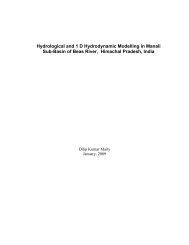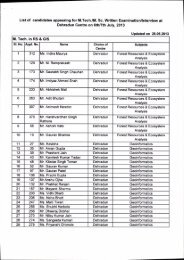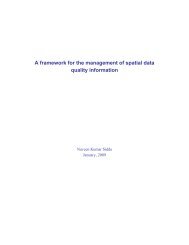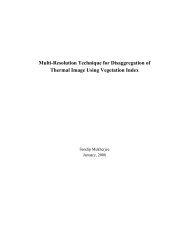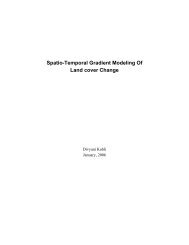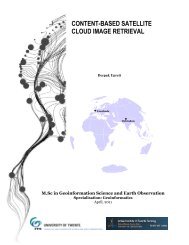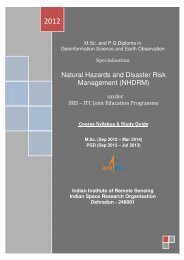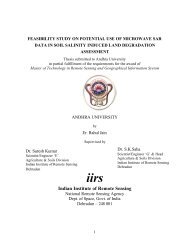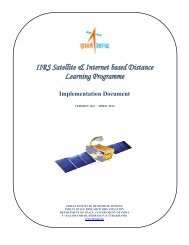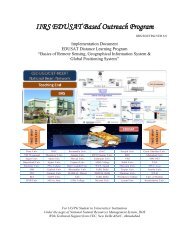Impact of Coal Mining on Vegetation: A Case Study in Jaintia Hills ...
Impact of Coal Mining on Vegetation: A Case Study in Jaintia Hills ...
Impact of Coal Mining on Vegetation: A Case Study in Jaintia Hills ...
You also want an ePaper? Increase the reach of your titles
YUMPU automatically turns print PDFs into web optimized ePapers that Google loves.
IMPACT OF COAL MINING ON VEGETATION: A CASE STUDY IN JAINTIA HILLS DISTRICT OF MEGHALAYA, INDIAsilt c<strong>on</strong>tent, the soils become compact form<strong>in</strong>g crust which <str<strong>on</strong>g>of</str<strong>on</strong>g>ten restrict seedl<strong>in</strong>g growth and entry <str<strong>on</strong>g>of</str<strong>on</strong>g>water and air <strong>in</strong>to the soil system. pH is a major determ<strong>in</strong>ant <strong>in</strong> c<strong>on</strong>troll<strong>in</strong>g plant growth <strong>on</strong>impoverished lands such as m<strong>in</strong>e spoils. The average value <str<strong>on</strong>g>of</str<strong>on</strong>g> pH is 3.5, which <strong>in</strong>dicates the acuteacidity <str<strong>on</strong>g>of</str<strong>on</strong>g> the soil (Johns<strong>on</strong> and Bradshaw, 1977).Intensive studies <strong>on</strong> the vegetati<strong>on</strong> characteristics <str<strong>on</strong>g>of</str<strong>on</strong>g> the m<strong>in</strong>ed areas have been undertaken <strong>in</strong> differentparts <str<strong>on</strong>g>of</str<strong>on</strong>g> the globe. The development <str<strong>on</strong>g>of</str<strong>on</strong>g> an ecosystem <strong>on</strong> ch<strong>in</strong>a-clay wastes was studied by Dancer etal. (1977). The vegetati<strong>on</strong> establishment <strong>on</strong> asbestos waste was studied by Moore and Zimmermann(1977). Saxena (1979) has provided a list <str<strong>on</strong>g>of</str<strong>on</strong>g> plant species for revegetati<strong>on</strong> <str<strong>on</strong>g>of</str<strong>on</strong>g> gypsum, bentomite andfuller’s earth m<strong>in</strong>ed areas <strong>in</strong> Rajasthan. Revegetati<strong>on</strong> <str<strong>on</strong>g>of</str<strong>on</strong>g> ir<strong>on</strong>-ore m<strong>in</strong>e areas <str<strong>on</strong>g>of</str<strong>on</strong>g> Madhya Pradesh wasstudied by Prasad <strong>in</strong> 1989 who observed better growth performance <str<strong>on</strong>g>of</str<strong>on</strong>g> Dalbergia sisso, Albizziaprocera, P<strong>on</strong>gamia p<strong>in</strong>nata etc. <strong>in</strong> the manured pits.The factors c<strong>on</strong>tribut<strong>in</strong>g to the early col<strong>on</strong>izati<strong>on</strong> <str<strong>on</strong>g>of</str<strong>on</strong>g> m<strong>in</strong>e dumps have given c<strong>on</strong>siderable attenti<strong>on</strong> byvarious workers. Bradshaw (1983), Chadwick (1973), Byrnes et al. (1973) found natural successi<strong>on</strong> <strong>on</strong>coal m<strong>in</strong>e spoils a slow process due to surface m<strong>in</strong><strong>in</strong>g alter<strong>in</strong>g physico-chemical properties. Thesespoils present a special habitat where c<strong>on</strong>diti<strong>on</strong>s are extremely unfavourable for plant growth andestablishment. Marrs and Bradshaw (1980) and Marrs et al. (1980 and 1981) studied the development<str<strong>on</strong>g>of</str<strong>on</strong>g> ecosystem <str<strong>on</strong>g>of</str<strong>on</strong>g> Ch<strong>in</strong>a clay waste. Ir<strong>on</strong> m<strong>in</strong>e tail<strong>in</strong>gs were studied by Leisman (1957) and Shetr<strong>on</strong> andDuffek (1970). Floristic diversity <str<strong>on</strong>g>of</str<strong>on</strong>g> lead m<strong>in</strong><strong>in</strong>g wastes was studied by Clarke and Clarke (1981), leadand z<strong>in</strong>c by Kimmerer (1984) and copper m<strong>in</strong><strong>in</strong>g wastes by Goodman and Gemmel (1978) andVeeranjaneyulu and Dhanaraju (1990).Doerr and Guernsey (1956) dealt with the envir<strong>on</strong>mental effects <str<strong>on</strong>g>of</str<strong>on</strong>g> strip m<strong>in</strong><strong>in</strong>g and undergroundm<strong>in</strong><strong>in</strong>g, which create c<strong>on</strong>spicuous landscape features and associated phenomena. Mukherjee (1987 and1988) described about the land degradati<strong>on</strong> associated with surface and sub-surface m<strong>in</strong><strong>in</strong>g. Chadwicket al. (1987) outl<strong>in</strong>ed the envir<strong>on</strong>mental implicati<strong>on</strong>s <str<strong>on</strong>g>of</str<strong>on</strong>g> <strong>in</strong>creased coal producti<strong>on</strong> and utilizati<strong>on</strong>.Chaudhury (1992) dealt with the impact <strong>on</strong> m<strong>in</strong><strong>in</strong>g activities <strong>on</strong> envir<strong>on</strong>ment and also the managementand protecti<strong>on</strong> <str<strong>on</strong>g>of</str<strong>on</strong>g> the m<strong>in</strong>ed areas.The ecology <str<strong>on</strong>g>of</str<strong>on</strong>g> the m<strong>in</strong>ed lands has been the subject <str<strong>on</strong>g>of</str<strong>on</strong>g> extensive study the world over (Bradshaw etal., 1986, Brenner et al., 1994, Rodrigues et al., 2004, Fretas et al., 2004, Wiegleb et al., 2001, Grant2003, Bell et al., 2001, Goretti 1998, Game et al., 1982). In India, Banerjee (1981), S<strong>in</strong>gh and Jha(1987), Valdiya (1988), Saxena (1979), Mann and Chatterjee (1979), Prakash (1998), S<strong>on</strong>i et al.(1989) have made pi<strong>on</strong>eer<strong>in</strong>g c<strong>on</strong>tributi<strong>on</strong>s to the ecology <str<strong>on</strong>g>of</str<strong>on</strong>g> Indian m<strong>in</strong>es. In the c<strong>on</strong>text <str<strong>on</strong>g>of</str<strong>on</strong>g>Meghalaya, studies have been d<strong>on</strong>e by Lyngdoh et al. (1992), Uma Shankar et al. (1993), Lyngdoh(1995), Tiwari (1996), Rai (1996), Das Gupta (1999), Das Gupta et al. (2002), Sarma (2002), Rai(2002), Dkhar (2002) and Swer and S<strong>in</strong>gh (2004).The state <str<strong>on</strong>g>of</str<strong>on</strong>g> Meghalaya is rich <strong>in</strong> m<strong>in</strong>eral resources. The coal deposits occur as th<strong>in</strong> seams, whichrange <strong>in</strong> thickness from 30 cm to 1.5 m <strong>in</strong> sedimentary rocks, sandst<strong>on</strong>e and shale <str<strong>on</strong>g>of</str<strong>on</strong>g> the Eocene age.The deposits <str<strong>on</strong>g>of</str<strong>on</strong>g> coal <strong>in</strong> the state are Cretaceous orig<strong>in</strong> (Guha Roy, 1991). The unscientific m<strong>in</strong><strong>in</strong>g <str<strong>on</strong>g>of</str<strong>on</strong>g>coal poses a serious threat to the envir<strong>on</strong>ment (Dadhwal, 1999). <str<strong>on</strong>g>M<strong>in</strong><strong>in</strong>g</str<strong>on</strong>g> <str<strong>on</strong>g>of</str<strong>on</strong>g> coal causes massivedamage to landscape and biological communities. The natural plant communities are disturbed bym<strong>in</strong><strong>in</strong>g activity because the m<strong>in</strong><strong>in</strong>g envir<strong>on</strong>ment alters the climatic and edaphic complexes <str<strong>on</strong>g>of</str<strong>on</strong>g> the plantcommunities lead<strong>in</strong>g to a drastic reducti<strong>on</strong> <strong>in</strong> the plant growth (Down and Stock, 1977). Acute scarcity6



